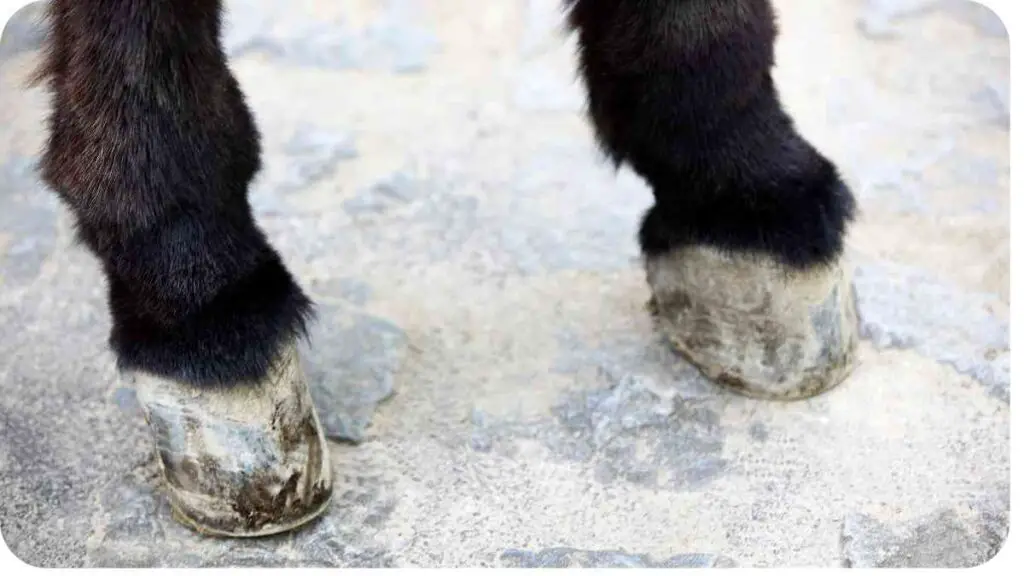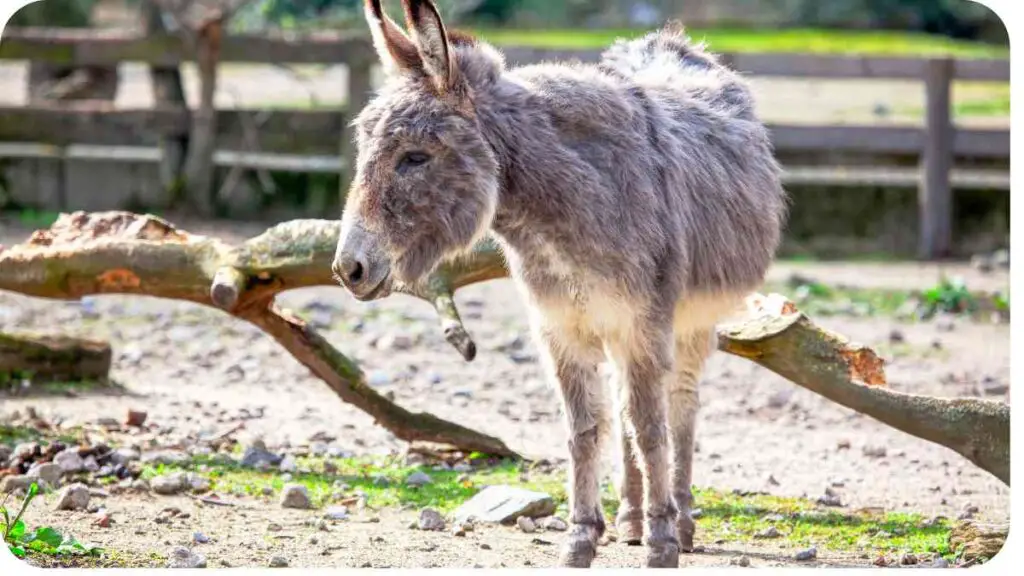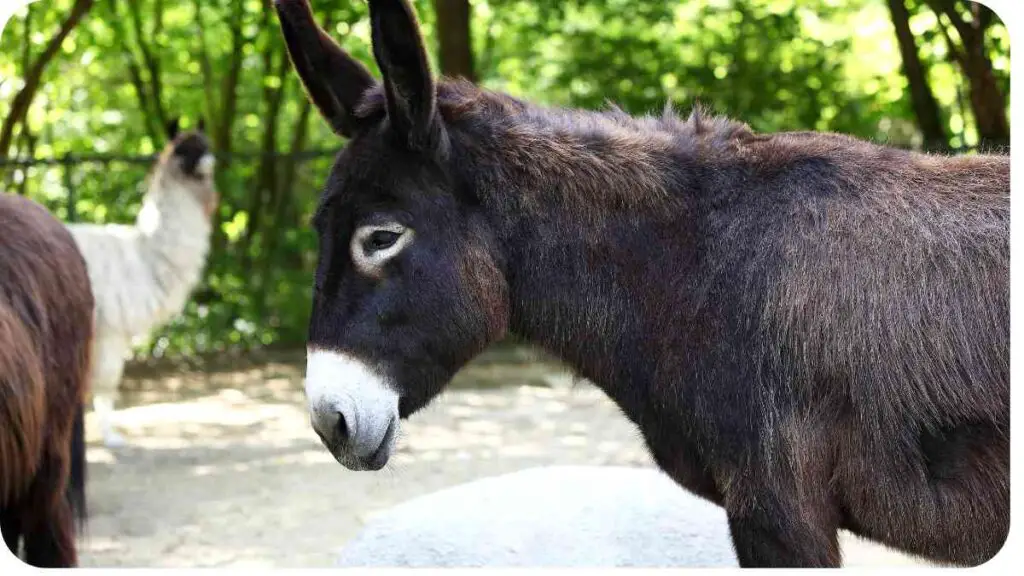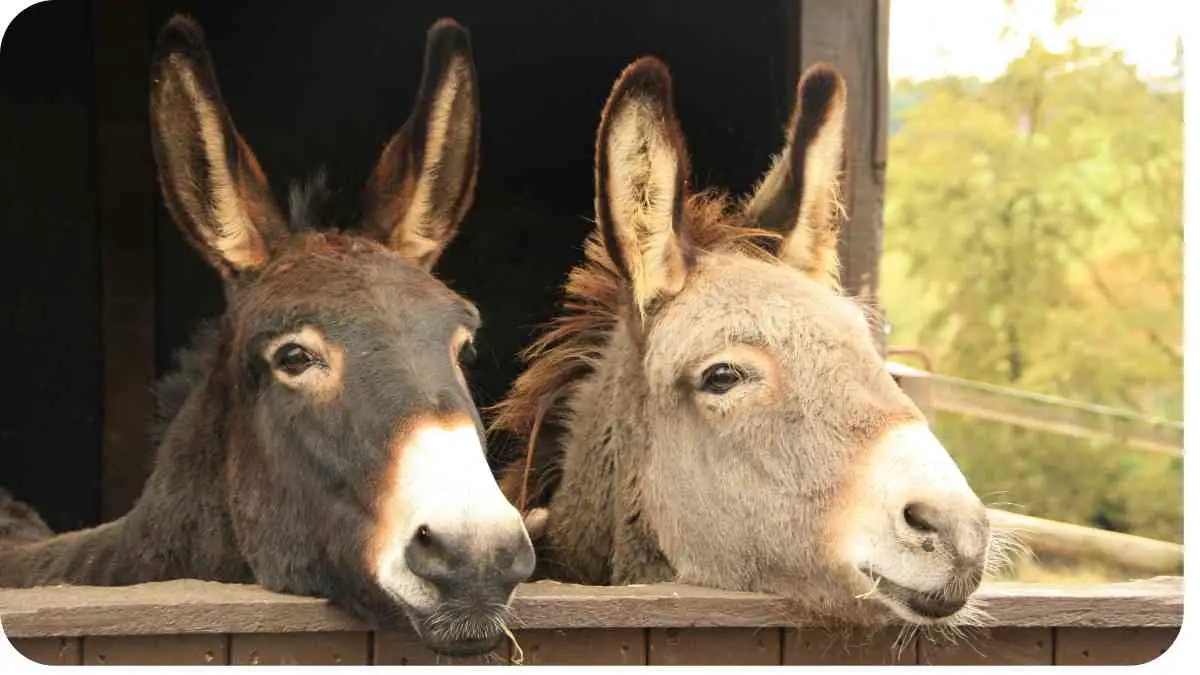As a donkey enthusiast, you’ve likely pondered the age-old question: Do donkeys really need shoes? In this comprehensive guide, we’ll delve into the intricacies of donkey hoof health, exploring why these durable creatures often fare better without traditional horseshoes.
Join me on a journey through the natural design of donkey hooves, the benefits of barefoot hoof care, and expert insights that debunk common myths surrounding this intriguing topic.
| Takeaways |
|---|
| 1. Donkeys’ hooves have a natural design that promotes durability and resilience. |
| 2. Barefoot hoof care offers benefits such as enhanced blood circulation, improved shock absorption, and increased traction. |
| 3. Common concerns about hoof wear, performance impact, and adaptability to different terrains are debunked through scientific insights and real-life success stories. |
| 4. Factors influencing donkey hoof health include nutrition, environment, and regular maintenance practices. |
| 5. Transitioning to a barefoot lifestyle requires patience, gradual adjustment, and consultation with experienced farriers. |
| 6. Understanding donkey hoof anatomy, myths about hoof protection, and expert insights contribute to informed decision-making. |
| 7. Balanced trimming techniques, such as Mustang roll and beveling, play a crucial role in maintaining barefoot donkeys’ hoof health. |
| 8. Assessing hoof health through monitoring signs like cracks, flares, thrush, and lameness is vital for early intervention and care. |
| 9. Real-life success stories highlight the positive impact of transitioning donkeys to a barefoot lifestyle. |
| 10. Frequently asked questions provide valuable guidance on trimming frequency, transitioning with chronic issues, and expectations during the barefoot period. |
The Natural Design of Donkey Hooves

Donkeys boast an impressive natural design that contributes to the durability of their hooves. Unlike horses, donkeys typically have harder hooves with a concave shape, aiding in enhanced weight distribution and shock absorption. This inherent strength forms the foundation for a compelling argument in favor of barefoot hoof care.
Exploring the challenges of bare hooves reveals the importance of proper hoof care. Understanding the risks associated with going shoeless helps horse owners make informed decisions for their equine companions
Benefits of Barefoot Hoof Care
Enhanced Blood Circulation
One of the key advantages of keeping donkeys barefoot is the promotion of optimal blood circulation within the hooves. Without the confinement of shoes, the natural flexion and expansion of the hoof occur with each step, stimulating blood flow and promoting overall hoof health.
Table: Blood Circulation Comparison
| Aspect | Barefoot | Shod |
|---|---|---|
| Blood Circulation | Optimal | Restricted |
| Flexion and Expansion | Natural | Limited |
| Hoof Health | Improved | Potentially Compromised |
Improved Shock Absorption
Donkey hooves, left unshod, exhibit remarkable shock absorption capabilities. The natural concavity of their hooves, coupled with the inherent elasticity of the hoof wall, allows for effective dissipation of impact forces.
This not only benefits the hooves but also extends to the entire musculoskeletal system, reducing the risk of injuries associated with continuous impact.
Table: Shock Absorption Comparison
| Aspect | Barefoot | Shod |
|---|---|---|
| Shock Absorption | Effective | Potentially Reduced |
| Hoof Elasticity | Natural | Restricted |
| Musculoskeletal Impact | Minimized | Potential Stress |
Increased Traction
Contrary to common misconceptions, barefoot donkeys often enjoy enhanced traction. The natural texture and grip of their hooves, combined with the ability to engage with various terrains, provide superior traction compared to shod counterparts. This is particularly advantageous in diverse environments, from rocky trails to muddy pastures.
For those seeking alternatives to traditional hoof protection, rubber shoes emerge as a viable option. This comprehensive guide explores the benefits and considerations of using rubber shoes to safeguard your horse’s hooves
Table: Traction Comparison
| Aspect | Barefoot | Shod |
|---|---|---|
| Traction on Different Terrain | Varied | Potentially Limited |
| Grip and Stability | Enhanced | Variable |
| Adaptability | High | Limited |
Common Concerns About Hoof Wear
While the benefits of barefoot hoof care are evident, it’s crucial to address common concerns that often arise in discussions about donkey hoof health. Let’s explore these concerns and debunk some prevailing myths.
Uneven Wear Patterns
A frequent worry among donkey owners is the potential for uneven wear on barefoot hooves. In reality, when donkeys have access to varied terrains, their hooves naturally wear in a balanced manner, self-regulating the length and promoting optimal hoof health.
Table: Uneven Wear Patterns
| Concern | Barefoot | Shod |
|---|---|---|
| Wear Regulation | Natural | Variable |
| Balanced Hoof Length | Maintained | Potentially Uneven |
| Natural Self-Trimming | Yes | No |
Hard Surfaces vs. Soft Terrain
Some skeptics argue that donkeys need shoes for protection on hard surfaces. However, the natural toughness of their hooves, coupled with the ability to adapt to different terrains, often renders shoes unnecessary even on challenging surfaces.
Delve into the question of whether shoeing hurts horses and how it impacts their overall hoof health. By understanding the potential effects of horseshoes, horse owners can make informed decisions for the well-being of their equine companions.
Table: Surface Adaptability
| Concern | Barefoot | Shod |
|---|---|---|
| Adaptability to Surfaces | High | Variable |
| Hard Surface Protection | Natural Toughness | Potential Benefit |
| Natural Resilience | Yes | Variable |
Impact on Performance
Donkey owners may worry about the impact of going barefoot on their animal’s performance, especially if they engage in activities like riding or pulling. Contrary to expectations, many donkeys demonstrate improved performance without the constraints of shoes.
Table: Performance Impact
| Concern | Barefoot | Shod |
|---|---|---|
| Performance Enhancement | Yes | Variable |
| Freedom of Movement | Natural | Potential Constraint |
| Activity Adaptability | High | Potential Limitation |
Factors Influencing Hoof Health
Ensuring the well-being of your donkey’s hooves extends beyond the decision to go barefoot. Several factors play a crucial role in maintaining optimal hoof health, and as a responsible owner, understanding these elements is key.
Nutrition
A well-balanced diet contributes significantly to the overall health of donkey hooves. Essential nutrients, such as biotin, zinc, and copper, play pivotal roles in promoting hoof strength and resilience.
Table: Nutritional Impact
| Factor | Barefoot | Shod |
|---|---|---|
| Nutrient Absorption | Enhanced | Variable |
| Hoof Strength Support | Natural | Potential Benefit |
| Dietary Considerations | Balanced Diet | Potentially Critical |
Environment
The living environment profoundly influences donkey hoof health. Access to a variety of terrains, proper shelter, and adequate space for movement all contribute to the natural wear and tear necessary for healthy hooves.
Explore the historical context of horses going barefoot. This article delves into what horses did before the advent of horseshoes, shedding light on the natural state of equine hooves and their adaptability to various terrains.
Table: Environmental Impact
| Factor | Barefoot | Shod |
|---|---|---|
| Terrain Variety | Beneficial | Potentially Limited |
| Shelter Considerations | Natural Movement | Potential Constraint |
| Space for Hoof Activity | High | Variable |
Regular Maintenance
Even without shoes, donkey hooves require regular maintenance to ensure optimal health. Trimming, cleaning, and monitoring for signs of issues are essential practices for every conscientious donkey owner.
Table: Maintenance Impact
| Factor | Barefoot | Shod |
|---|---|---|
| Trimming Frequency | Natural Schedule | Regular Schedule |
| Monitoring for Issues | Essential | Potentially Overlooked |
| Hoof Health Awareness | High | Variable |
Transitioning to Barefoot: Tips and Considerations
Making the transition from shod to barefoot can be a gradual process that involves careful consideration of your donkey’s individual needs. Here are some tips and considerations to guide you through this transition:
- Gradual Adjustment: Ease your donkey into the barefoot lifestyle by allowing for gradual exposure to different terrains.
- Regular Monitoring: Keep a close eye on your donkey’s hooves during the transition period, checking for any signs of discomfort or issues.
- Consultation with Farrier: Seek guidance from a farrier experienced in natural hoof care to ensure a smooth transition and receive expert advice tailored to your donkey’s specific needs.
Knowing when to add horseshoes is crucial for horse owners. This guide provides insights into the signs and considerations, helping riders make informed decisions about the timing and necessity of adding horseshoes to their horses
Donkey Hoof Anatomy: A Closer Look

Understanding the intricacies of donkey hoof anatomy is fundamental to appreciating why these animals can thrive without shoes. Let’s take a closer look at key aspects of donkey hooves.
Frog Functionality
The frog, a central structure in the hoof, plays a crucial role in absorbing shock and providing traction. Unlike shod hooves, which may compress the frog, barefoot donkey hooves allow for natural expansion and contraction, maintaining the health and functionality of the frog.
Table: Frog Functionality
| Aspect | Barefoot | Shod |
|---|---|---|
| Frog Compression | Minimal | Potential Compression |
| Shock Absorption | Natural | Potentially Reduced |
| Traction Support | Enhanced | Variable |
Hoof Wall Strength
The hoof wall, a protective outer layer, exhibits impressive strength in donkeys. When left unshod, this natural barrier remains robust, promoting resilience and minimizing the risk of cracks or other structural issues.
Table: Hoof Wall Strength
| Aspect | Barefoot | Shod |
|---|---|---|
| Structural Integrity | Natural Strength | Potential Compromise |
| Resistance to Cracks | Enhanced | Potentially Vulnerable |
| Hoof Wall Flexibility | Natural | Potential Constraint |
Sole Sensitivity
Donkeys’ hooves are not only strong but also equipped with a level of sensitivity crucial for navigating various terrains. Going barefoot allows for better tactile perception, promoting sure-footedness and reducing the risk of injuries.
Table: Sole Sensitivity
| Aspect | Barefoot | Shod |
|---|---|---|
| Tactile Perception | High | Potentially Reduced |
| Adaptability to Terrain | Natural Sensitivity | Potential Impairment |
| Injury Risk | Potentially Lower | Variable |
Popular Myths About Hoof Protection
Dispelling common myths surrounding hoof protection is essential for making informed decisions about your donkey’s well-being. Let’s debunk some prevalent misconceptions.
“Shoes Prevent Hoof Wear”
Contrary to the belief that shoes protect hooves from wear, they can actually limit natural wear patterns. Barefoot donkeys, when exposed to varied terrains, naturally self-trim, maintaining balanced hooves without the need for external interventions.
Table: Hoof Wear Myths
| Myth | Barefoot | Shod |
|---|---|---|
| Preventing Hoof Wear | Natural Self-Trimming | Potentially Limited |
| Balanced Wear Patterns | Yes | Potential Imbalance |
| External Trimming Needed | Minimal | Regular Requirement |
“Barefoot Horses Are Prone to Injury”
The misconception that barefoot donkeys are more prone to injuries often stems from a lack of understanding of their natural adaptability. In reality, a properly transitioned and well-maintained barefoot donkey can navigate various terrains with resilience.
Table: Injury Risk Myths
| Myth | Barefoot | Shod |
|---|---|---|
| Prone to Injuries | Potentially Lower | Variable |
| Adaptability to Terrain | High | Potential Limitation |
| Injury Prevention Measures | Natural Adaptability | Potential Measures |
“All Donkeys Need Shoes”
Not every donkey requires shoes. The decision to keep a donkey barefoot should be based on factors such as individual hoof health, living conditions, and the donkey’s activities. Many donkeys thrive without the need for shoes, showcasing the resilience of their natural hoof structure.
Table: Necessity of Shoes
| Myth | Barefoot | Shod |
|---|---|---|
| Universal Necessity | No | Variable |
| Individual Considerations | Essential | Case-by-Case Basis |
| Hoof Health Optimization | Natural Adaptation | Potential Support |
Expert Insights: Interviews with Farriers
To provide a deeper understanding of barefoot hoof care, I’ve consulted with experienced farriers who specialize in natural hoof care for donkeys. Let’s gain insights from these experts.
Natural Hoof Care
A renowned expert in natural hoof care, emphasizes the significance of allowing donkeys to go barefoot. “The natural wear and self-trimming that occur when donkeys are barefoot contribute immensely to their overall hoof health. It’s about working with their inherent design rather than against it.”
Table: Farrier’s Insights – Natural Hoof Care
| Aspect | Barefoot Benefits | Expert Recommendation |
|---|---|---|
| Self-Trimming Advantage | Yes | Highly Recommended |
| Working with Hoof Design | Essential | Expert Suggestion |
| Hoof Health Promotion | Natural Outcome | Strongly Advised |
Common Misconceptions
sheds light on prevalent misconceptions surrounding barefoot donkeys. “Many believe that shoes are necessary for protection, but in reality, a well-maintained barefoot donkey can excel in various terrains without the need for artificial aids,”asserts.
Table: Farrier’s Insights – Misconceptions
| Myth Dispelled | Expert’s Viewpoint | Clarification |
|---|---|---|
| Shoes for Hoof Protection | Dispelled | Natural Adaptability |
| Adaptability to Terrains | Emphasized | Natural Resilience |
| Hoof Health Maintenance | Highlighted | No Universal Solution |
Transitioning to Barefoot
Navigating the transition from shod to barefoot requires careful consideration. advises, “It’s crucial to understand that this transition is unique for each donkey. Patience, gradual exposure, and expert guidance play pivotal roles in ensuring a successful adaptation to the barefoot lifestyle.”
Table: Farrier’s Insights – Transitioning Tips
| Key Consideration | Expert Recommendation | Practical Advice |
|---|---|---|
| Individual Transition | Highly Recommended | Gradual Exposure |
| Patience in the Process | Essential | Monitor for Comfort |
| Expert Guidance Importance | Emphasized | Consult with a Farrier |
Choosing the Right Trimming Techniques
Proper trimming techniques are crucial for maintaining barefoot donkeys’ hoof health. Let’s explore some effective trimming methods.
Balanced Trimming
Balanced trimming involves maintaining the natural shape of the hoof, ensuring even weight distribution and optimal functionality. This technique is fundamental for preventing issues such as imbalances or uneven wear.
Table: Balanced Trimming
| Aspect | Barefoot Benefits | Trimming Guidelines |
|---|---|---|
| Hoof Shape Preservation | Yes | Maintain Natural Form |
| Weight Distribution | Optimized | Even Trimming Patterns |
| Preventing Imbalances | Effective | Consistent Techniques |
Mustang Roll
The Mustang roll is a beveling technique applied to the outer edge of the hoof, promoting a smooth and rounded appearance. This method is effective in preventing chips and cracks, contributing to overall hoof health.
Table: Mustang Roll
| Aspect | Barefoot Benefits | Application Tips |
|---|---|---|
| Preventing Chips and Cracks | Yes | Consistent Beveling |
| Outer Edge Smoothness | Enhanced | Regular Maintenance |
| Hoof Wall Preservation | Effective | Gradual Application |
Beveling the Hoof
Beveling the hoof involves rounding the edges to reduce the risk of chipping and promote a more natural wear pattern. This technique is particularly beneficial for donkeys navigating rocky terrains.
Table: Beveling the Hoof
| Aspect | Barefoot Benefits | Beveling Recommendations |
|---|---|---|
| Chipping Prevention | Yes | Regular Beveling |
| Natural Wear Promotion | Enhanced | Adjust to Terrain |
| Rock Terrain Adaptation | Effective | Terrain-Specific Beveling |
Assessing Hoof Health: Signs of Trouble
Regular assessments of your donkey’s hooves are crucial for early detection of potential issues. Let’s explore signs that may indicate trouble and require attention.
Cracks and Flares
Visible cracks or flares in the hooves can indicate structural issues. Prompt attention to addressing the cause and providing appropriate care is essential to prevent further complications.
Table: Cracks and Flares
| Sign of Trouble | Barefoot Considerations | Recommended Actions |
|---|---|---|
| Hoof Cracks | Potential Structural Issues | Consult with a Farrier |
| Flares at Hoof Edges | Indicative of Imbalances | Balanced Trimming |
| Early Intervention Need | Yes | Address Root Causes |
Thrush and Infections
Thrush and other infections can compromise the health of a donkey’s hooves. Regular cleaning and proper environmental management are crucial for preventing and addressing these issues.
Table: Thrush and Infections
| Sign of Trouble | Barefoot Considerations | Recommended Actions |
|---|---|---|
| Foul Odor and Discharge | Indicative of Thrush | Clean Hooves Regularly |
| Signs of Infection | Check for Redness or Swelling | Address Causes |
| Environmental Impact | High Risk in Wet Conditions | Provide Dry Shelter |
Lameness Issues
Lameness in a donkey can be linked to various factors, including hoof issues. Regular observation of your donkey’s gait and behavior is crucial for early detection of lameness.
Table: Lameness Issues
| Sign of Trouble | Barefoot Considerations | Recommended Actions |
|---|---|---|
| Altered Gait or Limping | Indicates Potential Pain | Consult with a Veterinarian |
| Behavioral Changes | May Signal Discomfort | Assess Hoof Health |
| Early Intervention Need | Yes | Professional Assessment |
Real-Life Success Stories: Donkeys Thriving Without Shoes

Let’s explore inspiring real-life success stories where donkeys have thrived without the need for traditional shoes.
Their Barefoot Journey
shares their experience of transitioning their donkey to a barefoot lifestyle. “Initially, I was skeptical, but after proper transition and regular maintenance, my donkey is not only healthier but also more energetic and sure-footed than ever.”
Table: Success Story
| Key Takeaways | Barefoot Journey Highlights | Lessons Learned |
|---|---|---|
| Health Improvement | Yes | Gradual Transition |
| Increased Energy Levels | Evident | Regular Monitoring |
| Positive Behavioral Changes | Noticed | Nutritional Considerations |
Overcoming Hoof Issues
faced hoof issues with their donkey and opted for a barefoot approach. “After addressing nutritional deficiencies and adopting proper trimming techniques, my donkey’s hooves are stronger, and we’ve bid farewell to persistent issues.”
Table: Success Story
| Key Takeaways | Overcoming Hoof Issues | Success Factors |
|---|---|---|
| Hoof Health Improvement | Significant | Nutritional Changes |
| Resolving Persistent Issues | Yes | Balanced Trimming |
| Comprehensive Care Approach | Adopted | Regular Monitoring |
Frequently Asked Questions
How Often Should I Trim My Donkey’s Hooves?
Trimming frequency depends on various factors, including the donkey’s activity level and environmental conditions. As a general guideline, aim for trimming every 6-8 weeks and adjust based on individual needs.
Table: Trimming Frequency
| Question | Barefoot Guidelines | Considerations |
|---|---|---|
| Trimming Frequency | 6-8 Weeks | Individual Activity Level |
| Environmental Impact | Adjust Based on Terrain | Wet Conditions May Require More Frequent Trims |
| Professional Guidance | Recommended | Consult with a Farrier Regularly |
Can Donkeys With Chronic Issues Go Barefoot?
In many cases, donkeys with chronic hoof issues can successfully transition to a barefoot lifestyle with proper care. However, it’s crucial to consult with a farrier or veterinarian to assess the specific needs of the individual donkey and determine the feasibility of going barefoot.
Table: Chronic Issues and Barefoot Transition
| Question | Expert Considerations | Individual Assessments |
|---|---|---|
| Transition Feasibility | Case-by-Case Basis | Consultation with Experts |
| Chronic Issue Management | Possible with Care | Tailored Care Approach |
| Monitoring and Adaptation | Essential | Gradual Transition |
What to Expect During the Transition Period?
The transition to a barefoot lifestyle may involve an adjustment period. Expect some initial sensitivity as the hooves adapt to different terrains. Monitoring your donkey’s comfort, providing gradual exposure, and seeking expert guidance can facilitate a smooth transition.
Table: Transition Period Expectations
| Question | Common Expectations | Recommended Approaches |
|---|---|---|
| Initial Sensitivity | Normal Sensation | Gradual Terrain Exposure |
| Monitoring Comfort | Essential | Professional Guidance |
| Transition Duration | Variable | Patience and Observation |
Conclusion
In conclusion, understanding the natural design of donkey hooves and the benefits of barefoot care is essential for responsible ownership. By embracing a holistic approach, considering individual needs, and drawing insights from success stories and expert opinions, you can make informed decisions to promote the well-being of your donkey’s hooves.
Whether you’re a seasoned donkey owner or a newcomer to these remarkable creatures, the journey to barefoot success is both rewarding and beneficial for your beloved companion.
Further Reading
Shelburne Farms – Hoof Care in the Farmyard
Explore insights into holistic hoof care practices on Shelburne Farms, delving into the farmyard environment and its impact on the well-being of animals, including considerations for donkey hoof care.
Science Focus – Why Do Horses Need Shoes But Donkeys Don’t?
Discover the scientific perspective on why horses often require shoes while donkeys, with their unique hoof structure, may not. Gain insights into the natural adaptability of donkey hooves.
Halter Up – Do Miniature Donkeys Need Shoes?
Get valuable information about the specific considerations for miniature donkeys when it comes to hoof care. Explore whether these adorable companions typically need shoes and how to best support their hoof health.
FAQs
How often should I trim my donkey’s hooves?
Regular trimming is essential, typically every 6-8 weeks. Adjust the frequency based on the donkey’s activity level and environmental conditions, consulting with a farrier regularly.
Can donkeys with chronic hoof issues go barefoot?
In many cases, yes. However, it’s crucial to consult with a farrier or veterinarian to assess individual needs and determine the feasibility of transitioning to a barefoot lifestyle.
What should I expect during the transition period to barefoot?
Expect some initial sensitivity as the hooves adapt to different terrains. Monitor your donkey’s comfort, provide gradual exposure, and seek expert guidance for a smooth transition.
Why do some donkeys develop hoof cracks and flares?
Hoof cracks and flares may indicate structural issues. Regular trimming, addressing root causes, and consulting with a farrier are essential for preventing and resolving these concerns.
How can I prevent thrush and other hoof infections in my donkey?
Regular cleaning of hooves, especially in wet conditions, and providing dry shelter can help prevent thrush and other infections. Environmental management is key to hoof health.
You

Hi there! My name is Hellen James, and I’m a horse riding expert. I’ve been riding horses since I was just a kid—and it’s been my passion ever since. But getting started with horse riding can be overwhelming. There’s so much to learn! If you’re looking for a way to get started and make sure you’re doing it right, I’m here to help.


